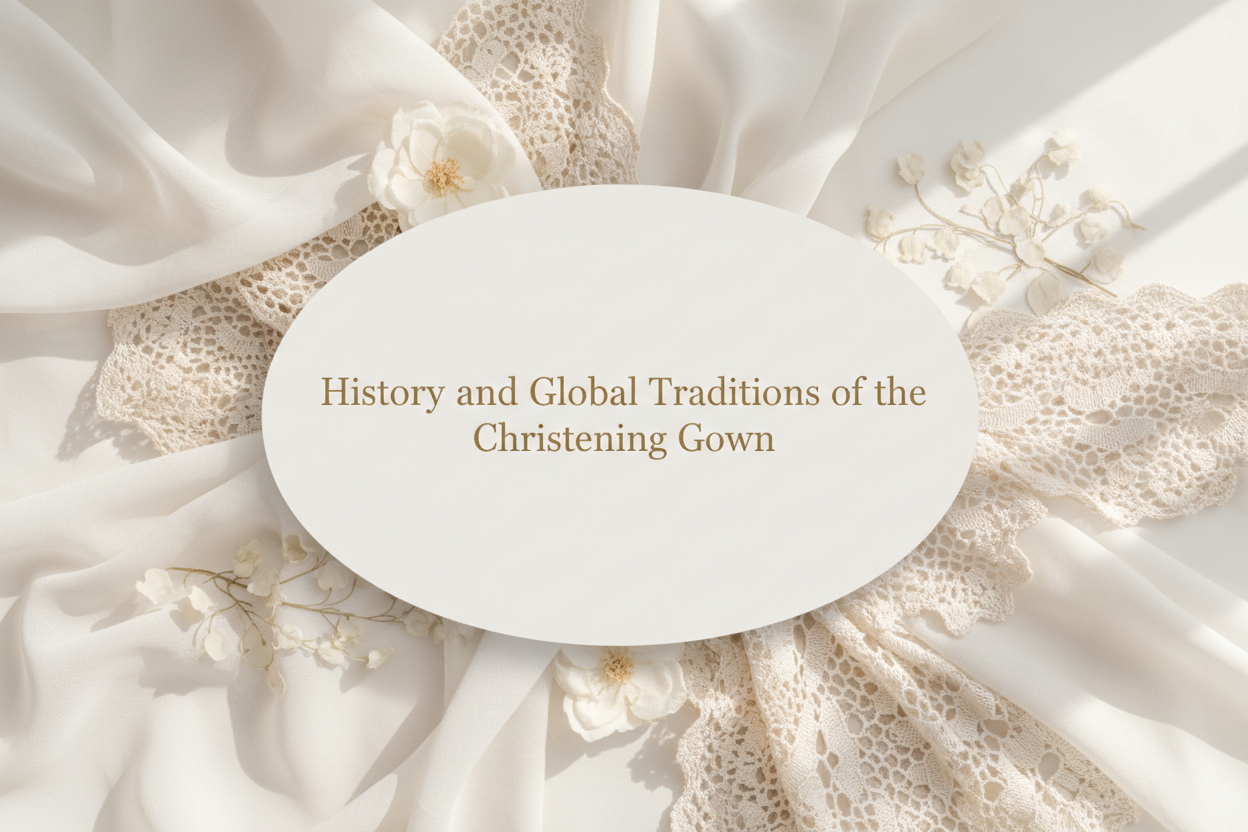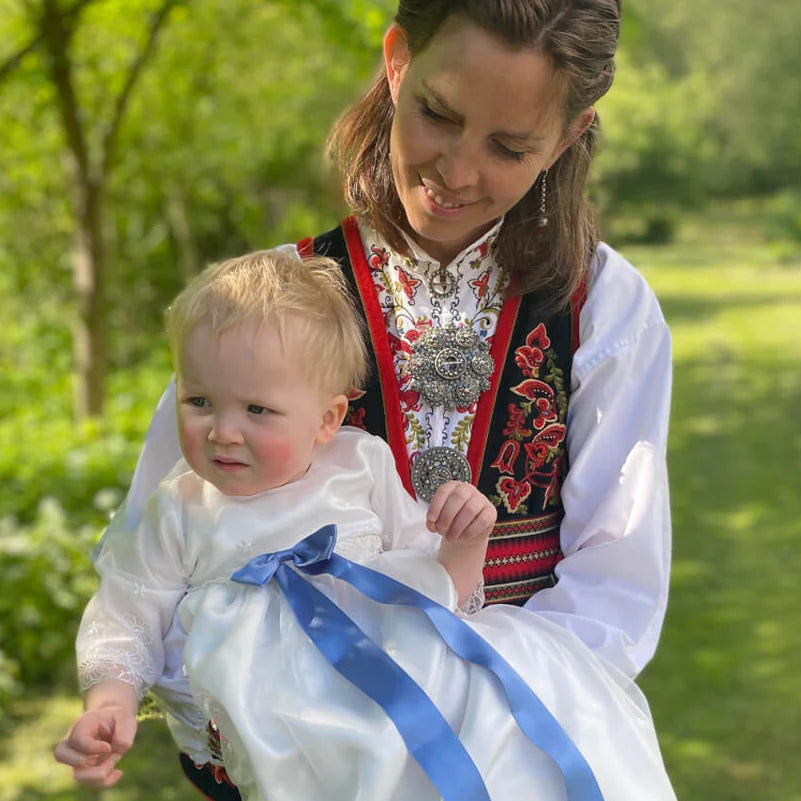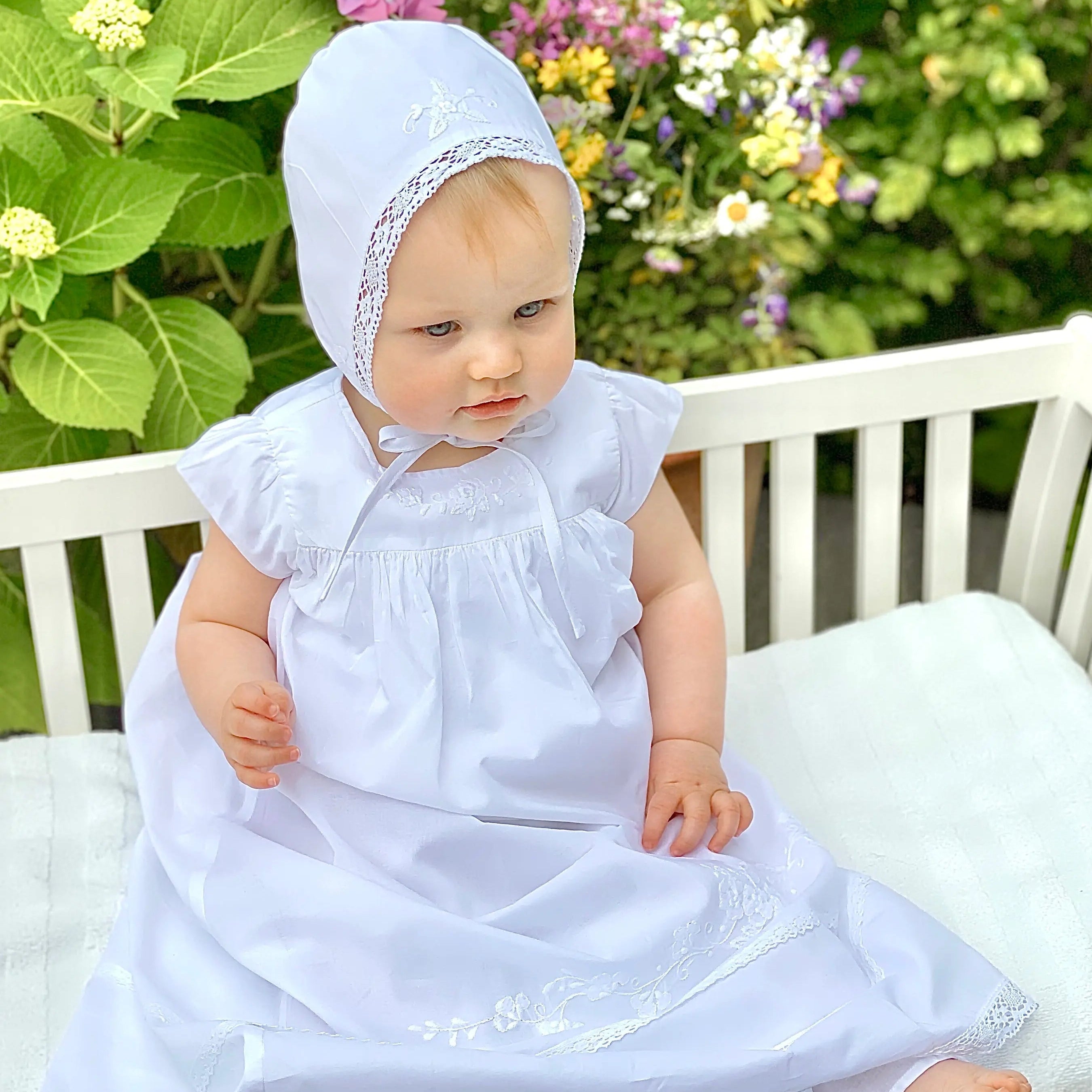Artikel: From Generation to Generation: The Enduring History and Global Traditions of the Christening Gown

From Generation to Generation: The Enduring History and Global Traditions of the Christening Gown
A deep-dive into the rich history, profound symbolism, and diverse cultural traditions of the christening gown—from its ancient roots to its modern role as a cherished family heirloom.
For centuries, the christening gown has been more than just an article of clothing. It is a symbol of faith, a vessel of tradition, and a tangible link connecting generations. But have you ever wondered why these gowns are almost always white? Why are they traditionally so long? And how have these customs evolved from ancient Christian practices to the cherished family heirlooms we know today?
This comprehensive guide explores the fascinating history of the christening gown, decodes its rich symbolism, and takes you on a journey through the diverse baptismal traditions of countries around the world—from the Nordic lands to the Americas and beyond.
The Ancient Roots of Baptismal Clothing: From Togas to Bearing Cloths
The tradition of special baptismal attire dates back to the earliest days of Christianity. In the Roman Empire, new converts were often baptized as adults, and the ceremony was a significant public event. After being fully immersed in water—a symbol of washing away past sins and being reborn into a new life—the newly baptized individual would be clothed in a white toga or alb. This white garment, known as the vestis alba, symbolized their newfound purity, innocence, and membership in the Christian community.
As infant baptism became more common from the 4th century onwards, the focus shifted from adult robes to garments suitable for babies. Initially, infants were simply wrapped in a "bearing cloth"—a large, often lavishly decorated cloth that the godparents would use to carry the baby to the church. These were not gowns but rather ornate pieces of fabric, sometimes made of silk or velvet and embroidered with family crests or religious symbols.
It wasn't until the late Middle Ages and the Renaissance that the concept of a dedicated christening garment began to take shape, evolving from the simple bearing cloth into a more structured piece of clothing.
The Victorian Era: The Birth of the Modern Christening Gown
The christening gown as we know it today is largely a product of the 19th century. The Victorian era, with its emphasis on family, sentimentality, and elaborate social rituals, elevated the christening ceremony to a major life event. Several factors contributed to the rise of the modern christening gown:
- The Rise of the Middle Class: A growing and affluent middle class sought to emulate the customs of the aristocracy, including elaborate christenings and dedicated ceremonial attire.
- The Industrial Revolution: The mass production of fine cotton and linen fabrics made these materials more accessible and affordable, allowing families beyond the wealthiest elite to create beautiful, lasting gowns.
- Queen Victoria's Influence: The christening of Queen Victoria's first child, Princess Victoria, in 1841 set a new standard for royal and, by extension, public christenings. The Honiton lace gown commissioned for the event became an instant icon and has been worn by every British monarch since. This single event cemented the christening gown as a symbol of tradition, heritage, and familial continuity.
During this period, christening gowns were often modeled after contemporary women's fashion, featuring high bodices, low scooped necklines, and long, flowing skirts. This is also when the tradition of making gowns from a mother's wedding dress became popular, further strengthening the link between generations.
The Symbolism Woven into Every Stitch
The Color White: A Symbol of Purity and New Beginnings
The most prominent feature of the christening gown is its color. White has been the universal color of baptismal garments since the early church, representing:
- Purity and Innocence: The baby is seen as pure and free from sin, a clean slate beginning their spiritual journey.
- Spiritual Rebirth: Just as the newly baptized were "reborn" in Christ, the white garment symbolizes this new, unblemished life.
- Divine Light and Goodness: In Christian iconography, white is the color of angels, saints, and divine light, representing the forces of good and the protection of God.
The Length of the Gown: A Journey of Faith
Another defining characteristic is the gown's extraordinary length, often extending far beyond the baby's feet. This tradition is not merely for aesthetic appeal; it carries deep symbolic weight:
- The Journey of Faith: The long gown represents the long life and spiritual journey the child has ahead of them. It is a visual prayer for a full and righteous life within the faith.
- Connection to Religious Robes: The length echoes the long robes worn by priests, monks, and other religious figures, symbolizing the child's entry into the universal Church.
- A Garment to Grow Into: Just as a child grows into their clothes, the long gown symbolizes the idea that the child will "grow into" their faith, with the grace and love of God always being greater than they can fully comprehend.
Materials and Embellishments: Weaving in Family and Culture
The choice of fabric and decoration also adds to the gown's significance. Traditional gowns are typically made from natural, breathable fabrics like linen, cotton, or silk, symbolizing the purity and natural state of the soul. Embellishments like lace, embroidery, and smocking were not just for decoration; they were a way for families to showcase their craftsmanship, wealth, and devotion. Intricate handwork turned the gown into a work of art, a precious offering for a sacred event.
Christening Gown Traditions Around the World
While the white gown is a near-universal symbol, its use and the surrounding traditions vary wonderfully across different cultures. The following table explores some of these diverse customs, highlighting how a single garment can be interpreted in so many unique ways.
| Country | Unique Traditions & Customs |
|---|---|
| USA | A very strong heirloom culture where gowns are passed down for generations, often with each child's name embroidered inside. Personalization is highly valued. |
| Canada | Similar to the US, with regional variations. In Quebec, French Catholic traditions are prominent, and Saint-Jean-Baptiste Day is a major cultural touchstone. |
| Netherlands | Historically, silver commemoration cups were a traditional gift. The national custom of serving "beschuit met muisjes" (rusks with anise seeds) is a key part of birth and baptism celebrations. |
| Finland | A highly detailed christening table setup is traditional, and godparents often gift an engraved silver spoon or plate. It is common to embroider the names of all children baptized in a gown onto its inner hem. |
| Denmark | A unique tradition is for the baby to have their first sleep after baptism in the christening gown, which is believed to ensure a good life. Planting an apple tree to grow with the child is also a cherished custom. |
| Sweden | A silver spoon engraved with a clock showing the baby's birth time is a traditional gift. The christening gown (dopklänning) is often much longer than the baby, symbolizing that the child will grow into their faith. |
| Norway | While the white gown is common, some Sami communities baptize children in a traditional 'kofte'. Godparents are expected to give a speech at the child's confirmation ceremony around age 15. |
| Germany | Godparents (Paten) play a significant role and are expected to give gifts for all major life events. A special baptismal candle (Taufkerze) is often lit during the ceremony and on subsequent anniversaries. |
| France | Godparents traditionally present the child with a medal or cross. After the ceremony, a "vin d'honneur" (wine of honor) reception is held for guests. |
| Greece | The ceremony involves triple immersion in water. Guests are given "koufeta" (sugar-coated almonds) as favors, symbolizing the bittersweet nature of life. |
| Philippines | Families often have an expansive network of godparents (ninongs and ninangs), and the baptism is followed by a large feast that can last for hours. |
| Ethiopia | Infants are wrapped in white "netela" wraps, and elders perform a traditional coffee ceremony to bless the child's life. |
| Ireland | Traditional gowns may feature shamrocks and other Celtic symbols. It is sometimes considered good luck for the baby to sleep in the gown the night before the christening. |
← Swipe to see all traditions →
The Christening Gown Today: A Bridge Between Past and Future
In our modern, fast-paced world, the christening gown remains a powerful symbol of continuity and connection. It is one of the few garments a person will ever wear that is created with the express purpose of being preserved and passed on. When a baby is wrapped in a gown worn by their parent, grandparent, or even great-grandparent, they are being wrapped in their family's history, love, and hopes for the future.
Whether it's a priceless antique passed down through a royal lineage or a simple cotton dress lovingly stitched by a grandmother, the christening gown is a testament to the enduring power of faith, family, and tradition. It is a beautiful reminder that while styles may change, the core values of love, purity, and new beginnings are timeless.
At Oli Prik, we are honored to be a part of this beautiful tradition. Our gowns are designed with the same care and attention to detail as the heirlooms of the past, created to be cherished not just for a day, but for generations to come.










